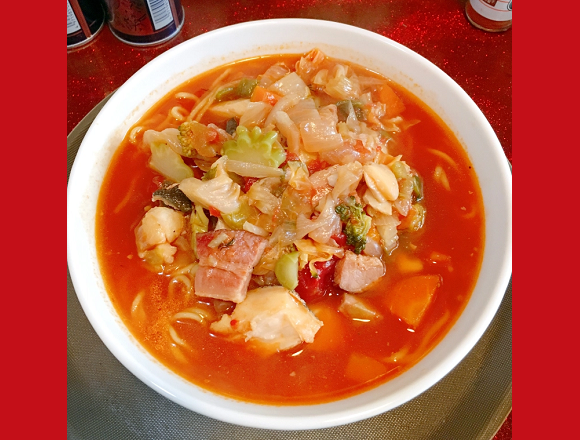
Smooth and slippery noodles are accompanied by some surprising sights.
While ramen is the type of noodle that Japan is most passionate about, the dish didn’t wholly originate in the country. Japanese-style ramen is actually the result local tinkering with the seasonings and cooking style of Chinese noodles, though the fact that it’s been going on for generations means that Japan’s ramen is now quite different from its original inspiration.
Because of this, while soba and udon, Japan’s two other popular noodle-forms, keep things pretty traditional, there’s more experimentation in the world of ramen. The first-ever ramen restaurant to be awarded Michelin star, for example, has influences from French cuisine in its use of truffle oil.
So when our Japanese-language correspondent Mr. Sato came across a restaurant in Tokyo offering “Brazilian-style ramen,” he figured it was worth a shot, because he’s always open to new culinary experiences that he can out on his expense account.
Located in the Ikebukuro neighborhood, the restaurant’s name, Akamaru, means “red circle,” and that’s exactly what you’ll see on the sign. The other distinctive decoration is, in Mr. Sato’s words, “A bone hanging from a chain attached to the building’s eves, like a baby.”
▼ Umm…this seems like an appropriate time to mention that Mr. Sato has no children.
While most ramen restaurants specialize in just noodles, Akamaru is actually only a ramen joint during the afternoon, while at night it changes into an izakaya (Japanese pub). The sign touts the restaurant’s “additive-free herb and spice fusion” fare, which intrigued Mr. Sato while keeping his vision of what he’d be eating hazy.
Taking a seat at the counter on the first floor, Mr. Sato cast his eyes over the ramen menu taped to the window. In addition to such standards as ramen with soy sauce-based and salty broths, the menu also listed something called white devil ramen. There were also black devil and red devil ramen, for those who need their food to have both an image color and a moral alignment.
But Mr. Sato, being a paragon of virtue, resisted those devilish temptations, because he had his heart set on going Brazilian with the special of the day: Brazilian-style ramen.
According to the sign advertising the unique dish, it makes use of cod, vegetables, and herbs. At 1,000 yen (US$9) it was a bit more expensive than the cheaper ramen options, but not an unreasonable price for something Mr. Sato had never seen on any other restaurant’s menu.
“Ah, so this is what Brazilian-style ramen looks like,” thought Mr. Sato as the server placed his food before him. Actually, he wasn’t sure how authentically Brazilian Akamaru’s ramen was, given that he’d neither seen nor heard of Brazilian ramen before this very day, but still, he couldn’t say it didn’t look like Brazilian ramen either.
Looking at the vibrantly colored broth, Mr. Sato could feel the rumbling in his stomach begin to pulse with a samba rhythm, but after he took a bite…
…he was tempted to sing out like a Venetian gondolier. “The flavor is pretty much minestrone,” he explained.
Of course, with minestrone enjoying widespread popularity in Japan (as well as many other parts of the world), this means that Akamaru’s Brazilian-style ramen is really tasty. There’s a strong vegetable flavor (something you’re unlikely to find in orthodox ramen), and also a touch of basil notes that please both the palate and the nose.
“I think it actually would have made more sense to call this ‘Italian-style healthy vegetable ramen,’” mused Mr. Sato. “I think it’d be really popular with female customers.”
▼ The cod was another non-traditional but delicious ingredient.
Of course, the whole reason Mr. Sato tried Akamaru’s ramen in the first place was because he wanted to find out what Brazilian-style ramen is. So in the end, it’s debatable whether the restaurant should call the dish Brazilian or Italian, but what we can say for sure is that it’s not Japanese, and not at all bad either.
Restaurant information
AKAMARU / アカマル
Address: Tokyo-to, Toshima-ku, Higashi Ikebukuro 1-13-12
東京都豊島区東池袋1-13-12
Open 11:45 a.m.-2 p.m., 6 p.m.- 10 p.m. (weekdays, Saturday), noon-4 p.m. (Sunday, holidays)
Closed Tuesdays
Photos ©SoraNews24
[ Read in Japanese ]

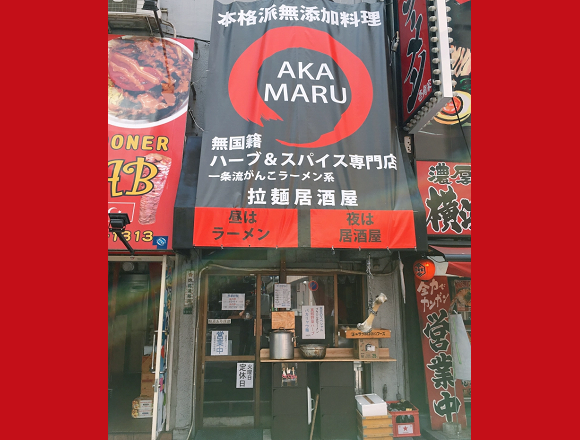
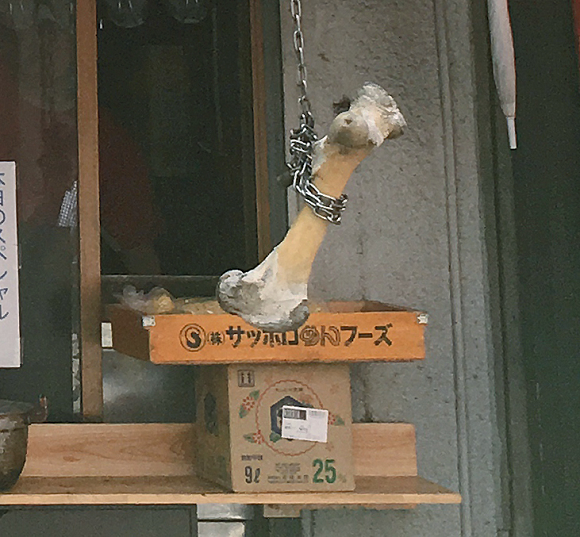
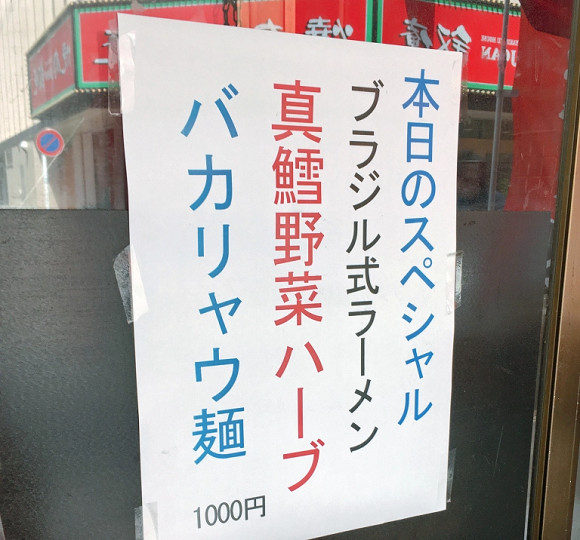
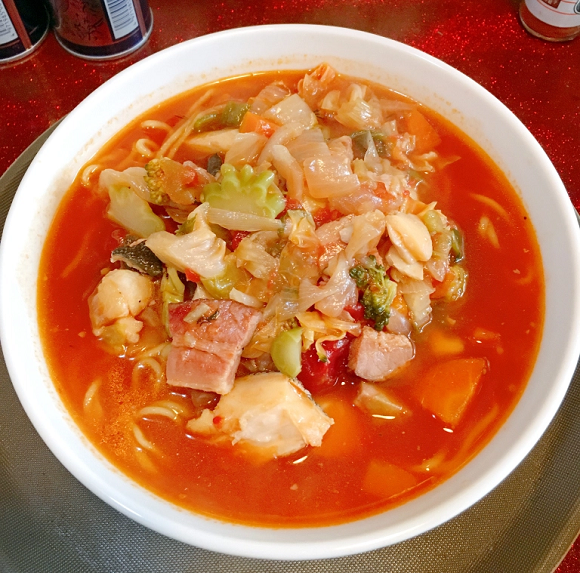
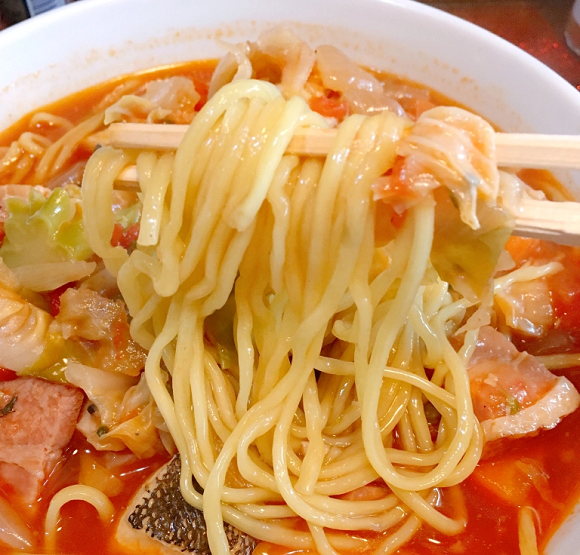
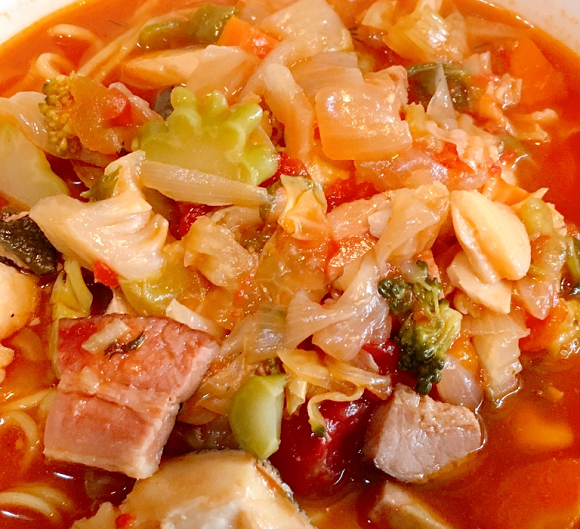
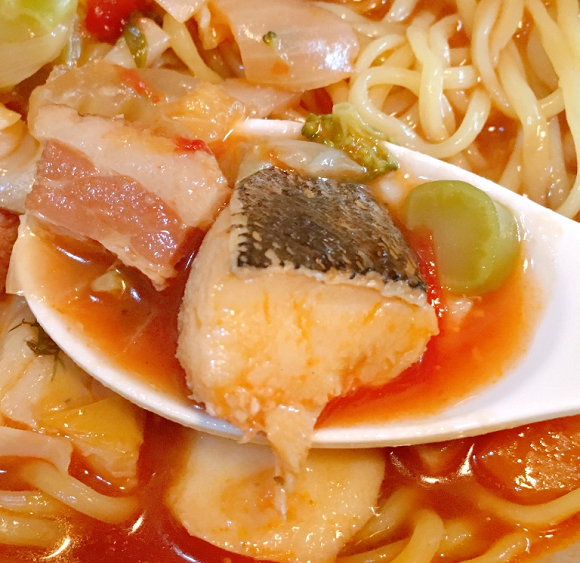
 Is ramen without the “men” a Tokyo dining paradox worth experiencing?【Taste test】
Is ramen without the “men” a Tokyo dining paradox worth experiencing?【Taste test】 We found a popular Japanese ramen chain in South Korea!…or so we thought
We found a popular Japanese ramen chain in South Korea!…or so we thought Ippudo serves up plant-based tonkotsu ramen in Japan for a limited time
Ippudo serves up plant-based tonkotsu ramen in Japan for a limited time Truck drivers love this Saitama Ramen Shop, but will it win our hearts?【Taste test】
Truck drivers love this Saitama Ramen Shop, but will it win our hearts?【Taste test】 2,500 yen for Tokyo ramen? High-end noodles in the high-rent Ginza district are totally worth it
2,500 yen for Tokyo ramen? High-end noodles in the high-rent Ginza district are totally worth it McDonald’s new Happy Meals offer up cute and practical Sanrio lifestyle goods
McDonald’s new Happy Meals offer up cute and practical Sanrio lifestyle goods All-you-can-drink Starbucks and amazing views part of Tokyo’s new 170 meter-high sky lounge
All-you-can-drink Starbucks and amazing views part of Tokyo’s new 170 meter-high sky lounge More foreign tourists than ever before in history visited Japan last month
More foreign tourists than ever before in history visited Japan last month Starbucks reopens at Shibuya Scramble Crossing with new look and design concept
Starbucks reopens at Shibuya Scramble Crossing with new look and design concept Beautiful Sailor Moon manhole cover coasters being given out for free by Tokyo tourist center
Beautiful Sailor Moon manhole cover coasters being given out for free by Tokyo tourist center Mister Donut ready to make hojicha dreams come true in latest collab with Kyoto tea merchant
Mister Donut ready to make hojicha dreams come true in latest collab with Kyoto tea merchant Studio Ghibli glasses cases let anime characters keep an eye on your spectacles
Studio Ghibli glasses cases let anime characters keep an eye on your spectacles Is the new Shinkansen Train Desk ticket worth it?
Is the new Shinkansen Train Desk ticket worth it? Arrest proves a common Japanese saying about apologies and police
Arrest proves a common Japanese saying about apologies and police The oldest tunnel in Japan is believed to be haunted, and strange things happen when we go there
The oldest tunnel in Japan is believed to be haunted, and strange things happen when we go there Disney princesses get official manga makeovers for Manga Princess Cafe opening in Tokyo
Disney princesses get official manga makeovers for Manga Princess Cafe opening in Tokyo We try out “Chan Ramen”, an underground type of ramen popular in the ramen community
We try out “Chan Ramen”, an underground type of ramen popular in the ramen community Beautiful new Final Fantasy T-shirt collection on the way from Uniqlo【Photos】
Beautiful new Final Fantasy T-shirt collection on the way from Uniqlo【Photos】 Foreign English teachers in Japan pick their favorite Japanese-language phrases【Survey】
Foreign English teachers in Japan pick their favorite Japanese-language phrases【Survey】 There’s a park inside Japan where you can also see Japan inside the park
There’s a park inside Japan where you can also see Japan inside the park Japanese convenience store packs a whole bento into an onigiri rice ball
Japanese convenience store packs a whole bento into an onigiri rice ball Studio Ghibli releases Kiki’s Delivery Service chocolate cake pouches in Japan
Studio Ghibli releases Kiki’s Delivery Service chocolate cake pouches in Japan Japan’s bone-breaking and record-breaking roller coaster is permanently shutting down
Japan’s bone-breaking and record-breaking roller coaster is permanently shutting down New definition of “Japanese whiskey” goes into effect to prevent fakes from fooling overseas buyers
New definition of “Japanese whiskey” goes into effect to prevent fakes from fooling overseas buyers Foreign passenger shoves conductor on one of the last full runs for Japan’s Thunderbird train
Foreign passenger shoves conductor on one of the last full runs for Japan’s Thunderbird train Our Japanese reporter visits Costco in the U.S., finds super American and very Japanese things
Our Japanese reporter visits Costco in the U.S., finds super American and very Japanese things Kyoto bans tourists from geisha alleys in Gion, with fines for those who don’t follow rules
Kyoto bans tourists from geisha alleys in Gion, with fines for those who don’t follow rules Studio Ghibli unveils Mother’s Day gift set that captures the love in My Neighbour Totoro
Studio Ghibli unveils Mother’s Day gift set that captures the love in My Neighbour Totoro Domino’s Japan now sells…pizza ears?
Domino’s Japan now sells…pizza ears? New Japanese KitKat flavour stars Sanrio characters, including Hello Kitty
New Japanese KitKat flavour stars Sanrio characters, including Hello Kitty Sales of Japan’s most convenient train ticket/shopping payment cards suspended indefinitely
Sales of Japan’s most convenient train ticket/shopping payment cards suspended indefinitely Sold-out Studio Ghibli desktop humidifiers are back so Totoro can help you through the dry season
Sold-out Studio Ghibli desktop humidifiers are back so Totoro can help you through the dry season Japanese government to make first change to romanization spelling rules since the 1950s
Japanese government to make first change to romanization spelling rules since the 1950s Ghibli founders Toshio Suzuki and Hayao Miyazaki contribute to Japanese whisky Totoro label design
Ghibli founders Toshio Suzuki and Hayao Miyazaki contribute to Japanese whisky Totoro label design Doraemon found buried at sea as scene from 1993 anime becomes real life【Photos】
Doraemon found buried at sea as scene from 1993 anime becomes real life【Photos】 Tokyo’s most famous Starbucks is closed
Tokyo’s most famous Starbucks is closed One Piece characters’ nationalities revealed, but fans have mixed opinions
One Piece characters’ nationalities revealed, but fans have mixed opinions We asked a Uniqlo employee what four things we should buy and their suggestions didn’t disappoint
We asked a Uniqlo employee what four things we should buy and their suggestions didn’t disappoint Princesses, fruits, and blacksmiths: Study reveals the 30 most unusual family names in Japan
Princesses, fruits, and blacksmiths: Study reveals the 30 most unusual family names in Japan Studio Ghibli’s new desktop Howl’s Moving Castle will take your stationery on an adventure
Studio Ghibli’s new desktop Howl’s Moving Castle will take your stationery on an adventure Instant vs. Restaurant Ramen Project: Ippudo spicy miso tonkotsu battle【Taste test】
Instant vs. Restaurant Ramen Project: Ippudo spicy miso tonkotsu battle【Taste test】 We were blown away by Funabashi Sauce Ramen, just a short ride from central Tokyo【Taste test】
We were blown away by Funabashi Sauce Ramen, just a short ride from central Tokyo【Taste test】 Mr. Sato investigates just how rich the new Kotteri Max ramen at Tenkaippin really is
Mr. Sato investigates just how rich the new Kotteri Max ramen at Tenkaippin really is Tokyo Ramen Show seeks to find the country’s best regional noodles
Tokyo Ramen Show seeks to find the country’s best regional noodles Ramen restaurant in Tokyo offers discount to customers who order ramen with no noodles
Ramen restaurant in Tokyo offers discount to customers who order ramen with no noodles Frozen pudding pops among the many surprises at Ramen Deniro in Tokyo
Frozen pudding pops among the many surprises at Ramen Deniro in Tokyo Takeout ramen broth: A new Tokyo winter noodle trend that’s worth the hype? 【Taste Test】
Takeout ramen broth: A new Tokyo winter noodle trend that’s worth the hype? 【Taste Test】 This Tokyo ramen restaurant is the first to ever receive a Michelin dining guide star
This Tokyo ramen restaurant is the first to ever receive a Michelin dining guide star The twin joys and dual sadnesses of eating ramen in the U.S.
The twin joys and dual sadnesses of eating ramen in the U.S. Japanese restaurant says its wonder ramen provides all the vegetables your body needs in one bowl
Japanese restaurant says its wonder ramen provides all the vegetables your body needs in one bowl This London ramen restaurant’s super-strange ramen shocks our Japanese taste-tester
This London ramen restaurant’s super-strange ramen shocks our Japanese taste-tester Ippudo ramen gives noodle lovers a fantastic fukubukuro lucky bag for 2020
Ippudo ramen gives noodle lovers a fantastic fukubukuro lucky bag for 2020 We try Tokyo’s new and trendy “smoky ramen” for a fragrant experience 【Photos】
We try Tokyo’s new and trendy “smoky ramen” for a fragrant experience 【Photos】 Build-it-yourself takeout ramen kits are our new favorite noodle lunch in Tokyo
Build-it-yourself takeout ramen kits are our new favorite noodle lunch in Tokyo Is Japan’s new Super Thick Ramen worth waiting two hours in the Tokyo cold for?【Taste test】
Is Japan’s new Super Thick Ramen worth waiting two hours in the Tokyo cold for?【Taste test】 Our Japanese reporter eats instant ramen from a bag for (almost) the first time in his life
Our Japanese reporter eats instant ramen from a bag for (almost) the first time in his life
Leave a Reply